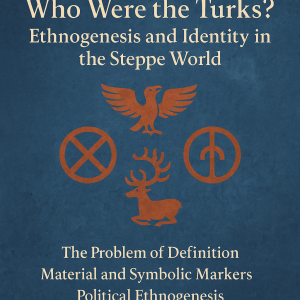1 · The Problem of Definition
When historians use the word Türk, they are rarely speaking of the same thing.
In Chinese dynastic records, Tujue (突厥) first appears in the Book of Zhou (Zhoushu, 636 CE) to describe a political confederation in the eastern steppes.
In the Orkhon Inscriptions (732–735 CE) we finally meet a self-designation: Türük Bodun, “the Turkic people.”
Between those two moments lies a thousand-year evolution of steppe confederations, languages, and ritual practices that gradually converged into what later sources call the Turkic world (Golden 1992; Taşağıl 2013).
The task is therefore not to locate a single ancestor tribe but to trace a process of ethnogenesis — how language, alliance, and shared memory formed a new identity.

2 · Linguistic Horizons
Comparative linguistics places Proto-Turkic between the late second and early first millennia BCE, centered in the Altai–Sayan corridor.
Core vocabulary reveals deep internal cohesion (verbs of motion, pronouns, vowel harmony) but also contact with early Mongolic and Tungusic lexicons, suggesting a broad interaction zone (Erdal 2004).
The older “Altaic hypothesis” treated these resemblances as evidence of common descent, whereas later scholars such as Doerfer (1966) viewed them as results of long-term diffusion.
Semih Güneri (2021) revisited the question archaeologically, showing that Bronze-Age metallurgical centers in the Altai–Minusinsk basin (2000–1200 BCE) coincide with the distribution of early Turkic material culture.
The linguistic map thus mirrors metallurgy and mobility rather than isolation.
3 · Material and Symbolic Markers
From the Karasuk (1400–800 BCE) through the Tagar (800–200 BCE) cultures, communities buried their dead in kurgans with horse trappings, clan tamgas, and animal-style bronze plaques (Güneri 2020; Işıklı 2010).
Recurring symbols — the winged predator, the stag, the solar disc — formed a trans-Eurasian visual language of power.
By the early centuries CE, these motifs persisted among the Xiongnu and Rouran.
When the Ashina clan founded the Göktürk Khaganate (552 CE), it inherited not only territory but also this shared symbolic repertoire.
Thus, long before the ethnonym Türk appeared, a recognizable material and ideological culture already linked these peoples.
4 · Political Ethnogenesis
Chinese annals describe the Ashina Türks as former iron-workers who rebelled against their Rouran overlords and forged a new empire stretching from the Altai to the Caspian (Zhoushu ch. 50; Taşağıl 2013, 58-61).
Whether literal or mythic, this metallurgical legend conveys a political truth: technology and mobility underwrote sovereignty.
From 552 to 630 CE, the First Göktürk Khaganate united dozens of tribes under a central hierarchy.
After a Tang interregnum, the Second Khaganate (682–744 CE) re-asserted autonomy and left behind the Orkhon Inscriptions — the earliest Turkic texts.
These monuments record not mere conquest but political reflection: why unity failed, why justice (törü) mattered, and how rulers should preserve the people’s fate.
5 · Language and Power
The Orkhon texts of Kül Tigin, Bilge Kağan, and Tonyukuk articulate a collective identity: Biz Türük Bodun — “We, the Turkic people.”
They contrast internal betrayal (budun elinden çıktı, “the people left their realm”) with cosmic order (Tengri yaratmış Türük bilge kağan oldu, “He whom Heaven created became the wise Kağan”).
This fusion of moral and political vocabulary is unique in steppe epigraphy and marks the moment when the Turkic world became a self-aware political civilization (Tekin 1995; Klyashtorny 1998).
6 · Genetic and Anthropological Continuity
Ancient-DNA studies demonstrate long-term continuity across the eastern steppe.
Genome data from Khövsgöl and Yenisei burials (3000 BCE–1300 CE) show admixture but no sudden replacement (Jeong et al. 2020).
Nomadic societies were dynamic yet rooted — mobile herders exchanging genes and culture along ecological corridors rather than conquering by annihilation.
Physical anthropology aligns with this: cranial series from Tagar to Göktürk levels change gradually, paralleling linguistic diffusion.
The Turkic world was therefore an emergent frontier civilization, not an imported ethnicity.
7 · Conclusions
By the mid-eighth century, a coherent Turkic identity stretched from Mongolia to Transoxiana.
It shared one literary language, a horse-based economy, and the moral-political principle of törü* — law as cosmic order.
Its roots lay in multi-ethnic Bronze-Age cultures; its voice was inscribed in stone.
To ask “Who were the Turks?” is to trace how ecology, technology, and collective memory converged into a civilization that would soon meet Islam and reshape Eurasia.
*
Footnote — On the term törü
The word törü (𐱅𐰇𐰼𐰇), attested in the Orkhon inscriptions (8th c. CE), denotes both “law” and “cosmic order.”
It survives in later Turkic languages as töre (e.g., Old Anatolian Turkish, Kazakh, Kyrgyz), carrying the sense of customary law or moral tradition.
In early inscriptions, törü signifies not a written code but the moral-political balance linking ruler, realm, and Heaven.
Selected References
Clauson G. (1972). An Etymological Dictionary of Pre-Thirteenth-Century Turkish. Oxford.
Damgaard P. B. et al. (2018). “The Steppe and the Spread of Indo-European Languages.” Nature 555: 197–203.
Doerfer G. (1966). Zur Stellung des Altaischen. Wiesbaden.
Erdal M. (2004). A Grammar of Old Turkic. Leiden: Brill.
Golden P. B. (1992). An Introduction to the History of the Turkic Peoples. Wiesbaden: Harrassowitz.
Güneri S. (2020). Altay Arkeolojisi ve Türk Kültür Kökenleri. Ankara: TTK.
Güneri S. (2021). Türk-Altay Kuramı. Ankara: TTK.
Işıklı M. (2010). “Eastern Anatolia and the Origins of Steppe Cultures.” Anadolu Arkeolojisi 15: 33–57.
Jeong C. et al. (2020). “A Dynamic 6,000-Year Genetic History of Eurasia’s Eastern Steppe.” Cell 183(4): 890–904.
Klyashtorny S. (1998). The Orkhon Inscriptions and Turkic Political Ideology. St Petersburg.
Sinor D. (1990). The Cambridge History of Early Inner Asia. Cambridge University Press.
Taşağıl A. (2013). Kök Tengri’nin Çocukları. İstanbul: Bilge Kültür.
Tekin T. (1995). Orhon Yazıtları. Ankara: TTK.